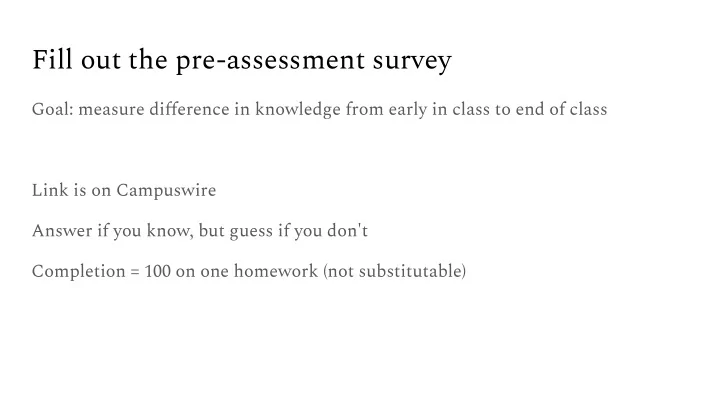

Fill out the pre-assessment survey Goal: measure difference in knowledge from early in class to end of class Link is on Campuswire Answer if you know, but guess if you don't Completion = 100 on one homework (not substitutable)
Feb 13: Data generating processes, likelihood comparisons
n Choose k Connection between sequences and counts. How many binary sequences of length n have k ones (and n-k zeros)? How many ways can you divide n things into two groups, where one group is of size k ? n! (a+b)! comb(n, k) (n-k)!k! a!b!
Three distributions (so far) ● Binomial ○ Out of n trials, x successes with probability p ○ 0 to n ● Geometric ○ x successes before first failure with probability p ○ no upper bound, always decreasing ● Poisson ○ x events with rate λ within an interval ○ no upper bound
Variations of a distribution ● Geometric ○ x successes before first failure with probability p -or- ○ x trials including first failure with probability p
Which distribution? ● Length of a team's winning or losing streak ● Number of hits in a baseball game ● Number of wins in a team's season
Reversing Data Generating Process: Prediction 1 2 3 4 Source: Wikipedia, Flickr
Reversing Data Generating Processes: inference [4, 4, 3, 2, 3] Source: Wikipedia, Flickr
Thinking about log probability probability log(x) Multiplying probabilities causes the overall probability to get very small very fast. 1.0 The probability of 44 streak lengths log probability is 0.0000000000000000000000000000000000000014694 Dealing with log probabilities is much easier, but we have to remember that multiplication always becomes addition.
Thinking about log probability probability log(x) All probabilities are between 0 and 1 (x-axis), so all log probabilities are negative, and between -infinity and 1.0 0 (y-axis). Log is monotonic , meaning that if log probability P(X) > P(Y), it is also true that log(P(X)) > log(P(Y)). As probability increases, log probability also increases.
Recommend
More recommend